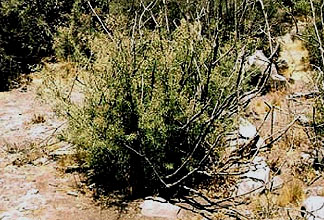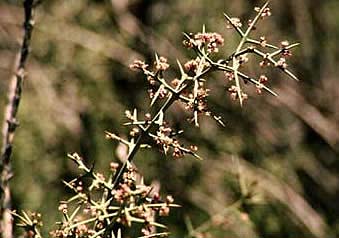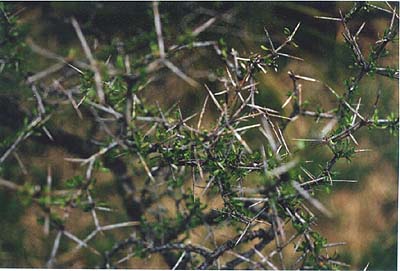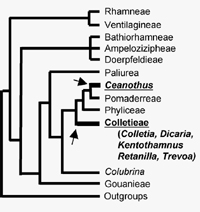

Colletia hystrix crown-sprouting after fire (Chile)
Thorns and flowers of C. hystrix (Chile, (D. Benson)
Actinorhizal Rhamnaceae Species |
||
| Ceanothus sp. (currently about 60 species) Ceanothus americanus L. C. cuneatus (Hook.) Nutt |
C. velutinus Dougl.ex Hook. Colletia (17 species) Discaria (15 species) |
Kentrothamnus (1 species) Retanilla Trevoa (including Talguenea) |
(Ecology of the Rhamnaceae symbioses)
The Rhamnaceae is distributed worldwide. It contains 50 genera and about 900 species (Richardson, et al., 2000). The angiosperm rbcL phylogeny places the Rhamnaceae with the Elaeagnaceae in the Rosales (Richardson, et al., 2000).

Six out of the 50 genera within the Rhamnaceae have been identified as "actinorhizal." Except for Ceanothus L., all belong to the tribe Colletieae Reis. Ex. Endl. These genera are: Colletia Comm. ex Juss.(17 species in South America), Discaria Hook. (15 species in South America, Australia, and New Zealand), Kentrothamnus Susseng. and Overk. (1 species restricted to Bolivia), Retanilla (DC) Brongn. (4 species found in Peru and Chile), and Trevoa Mires ex. Hook. (1 species found in South America). Talguenea has been included in the genus Trevoa (Tortosa, 1992). The one member of the tribe Colletieae whose actinorhizal nature is unconfirmed is Adolphia Meisner., located in southwestern North America (Cruz-Cisneros and Valdés, 1991).
The other actinorhizal genus in the Rhamnaceae is Ceanothus L., a strictly North American genus of approximately 55 species (Mabberely, 1988). Most nodulated members of the Rhamnaceae grow in dry matorral or chaparral regions.
Molecular phylogenies constructed for the Rhamnaceae found that the five genera within the tribe Colletieae were monophyletic (Richardson, et al., 2000). However, Ceanothus did not cluster with the Colletieae, suggesting that the actinorhizal symbiosis may have emerged twice within the Rhamnaceae. Of particular note is the association of Ceanothus species with Frankia from a different clade than those that infect genera of the Colletiae (more).

The Rhamnaceae appears to be an old lineage. A rhamnaceous flower has been found dating to 94-96 Mybp (Basinger and Dilcher, 1984).
Both Ceanothus and the tribe Colletieae belong to a larger clade within the family termed the ziziphoid group, that is mostly distributed in the southern hemisphere, suggesting that this branch of the family may be of Gondwanan origin. The major exception to this distribution is the genus Ceanothus, that may have been part of the ziziphoid group with a Laurasian distribution before the Gondwanan split and now has a relictual distribution in North America, primarily California (Richardson et al., 2000). This hypothesis requires that the genus Ceanothus be quite old (65 Mybp). An ancient split between Ceanothus and the tribe Colletieae may explain why the two groups differ in the Frankia strains with which they associate (Benson et al., 2004).